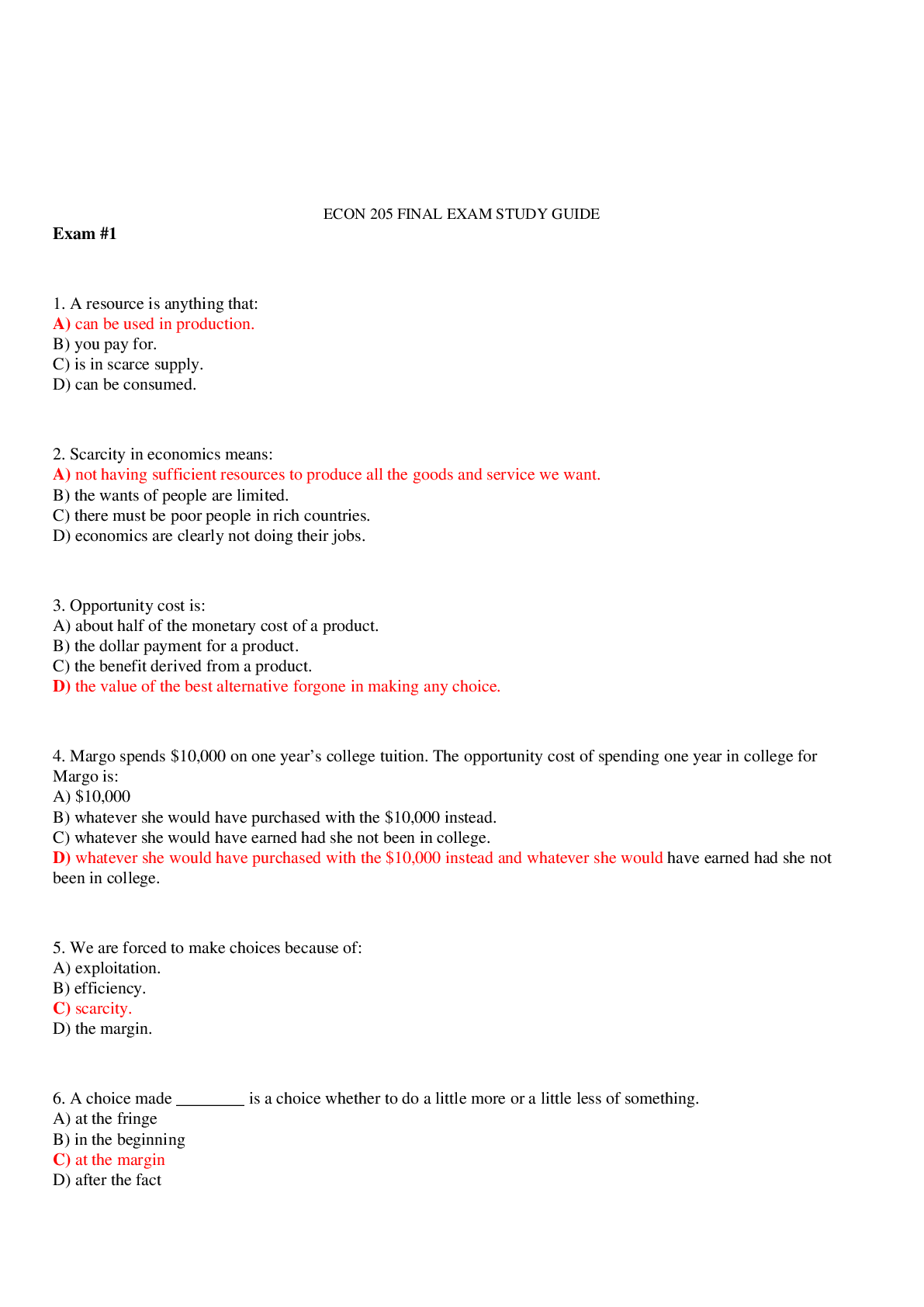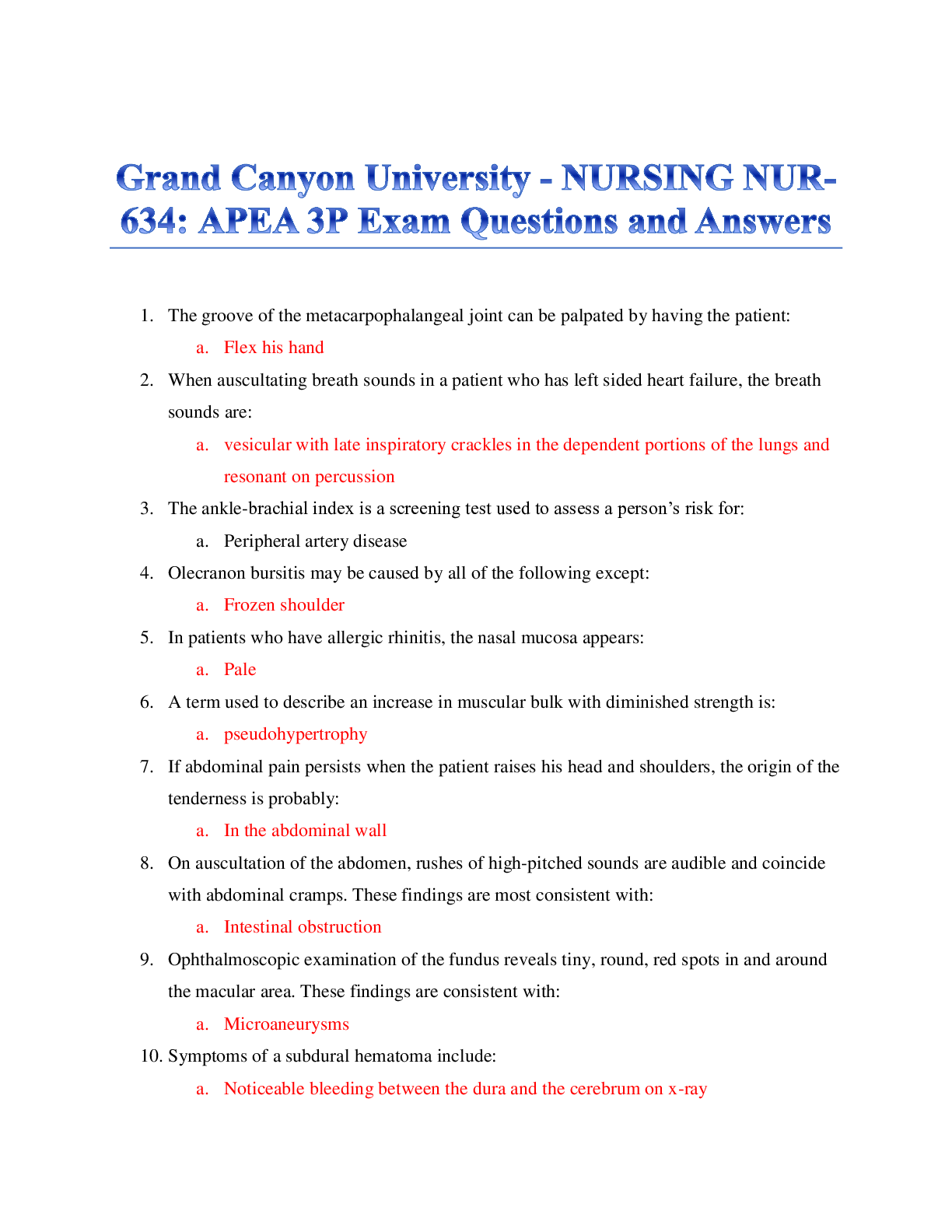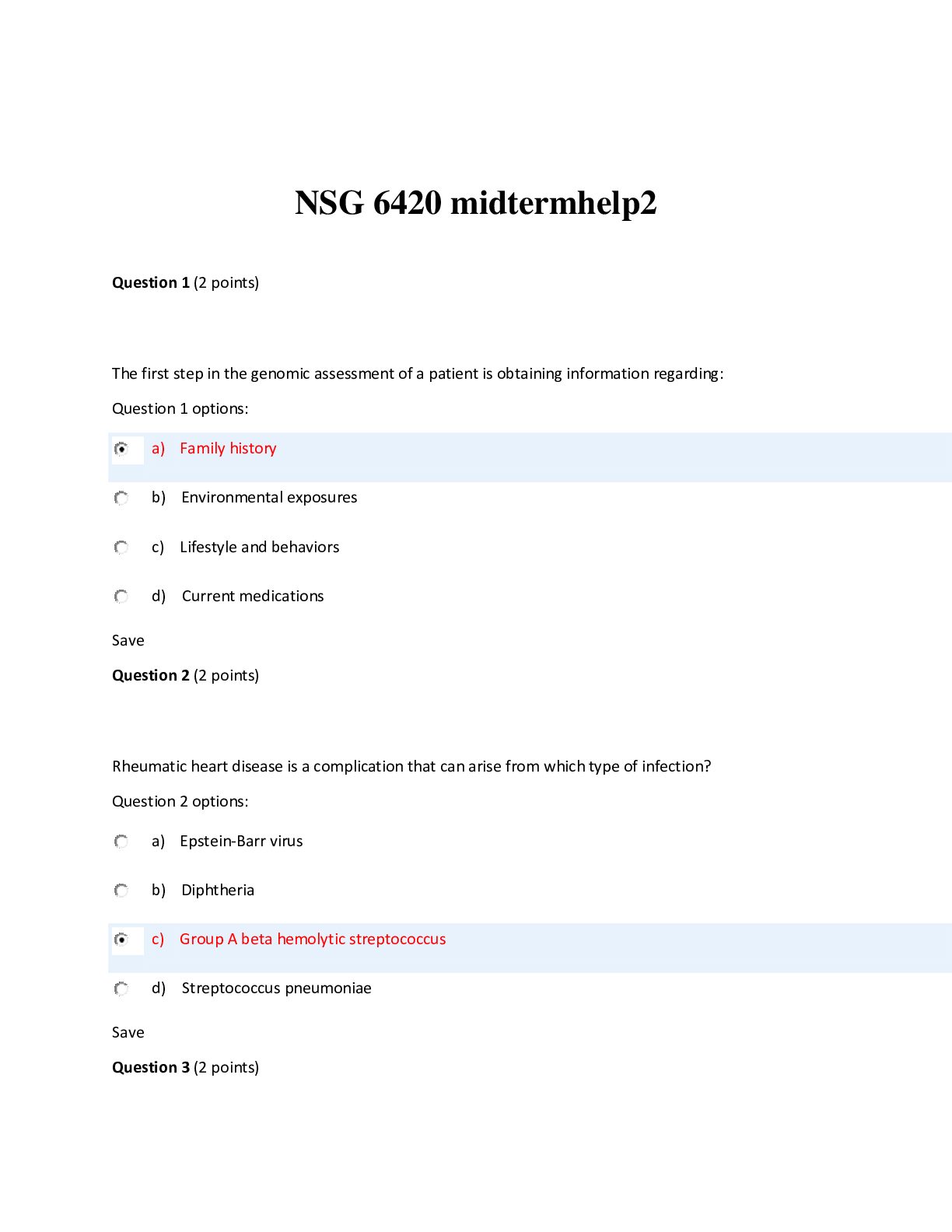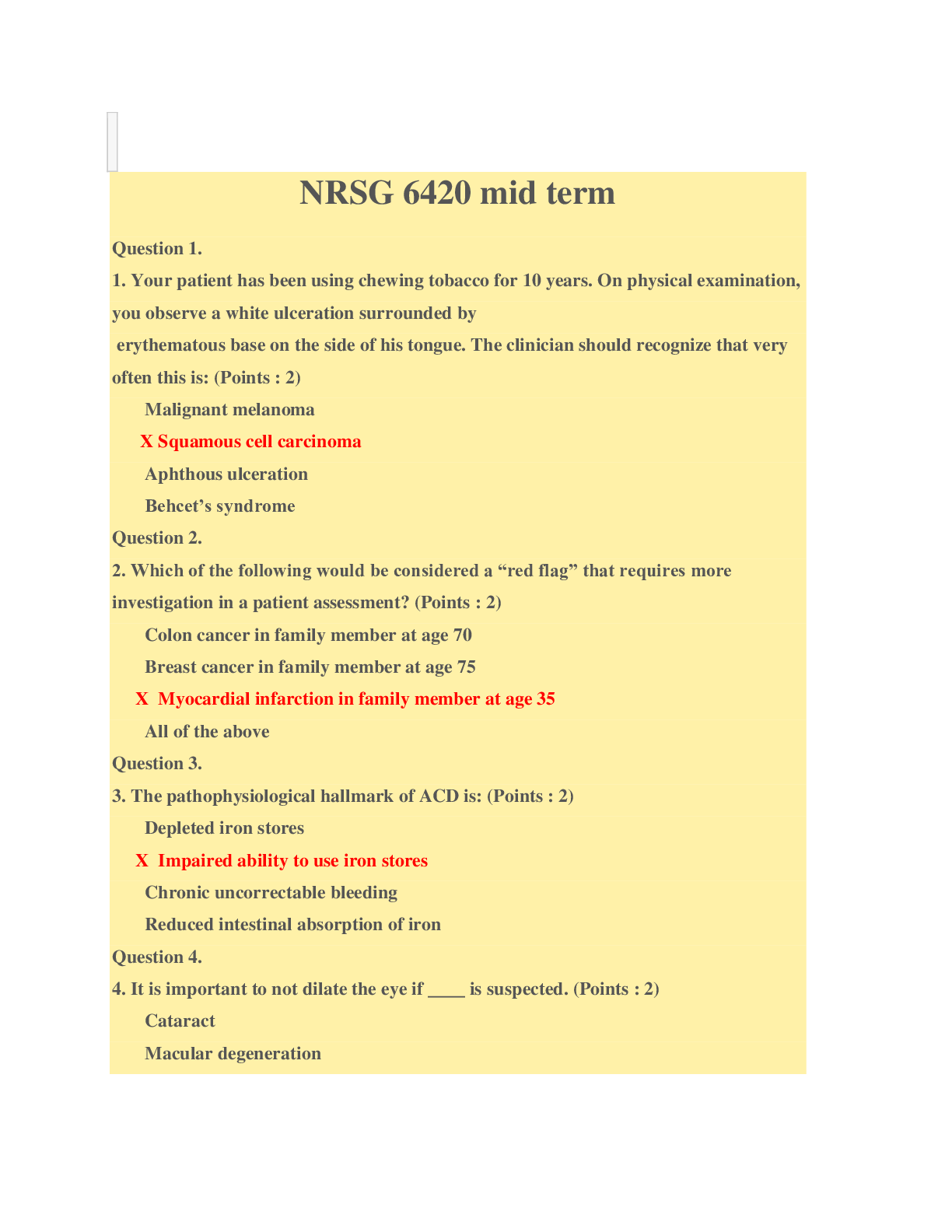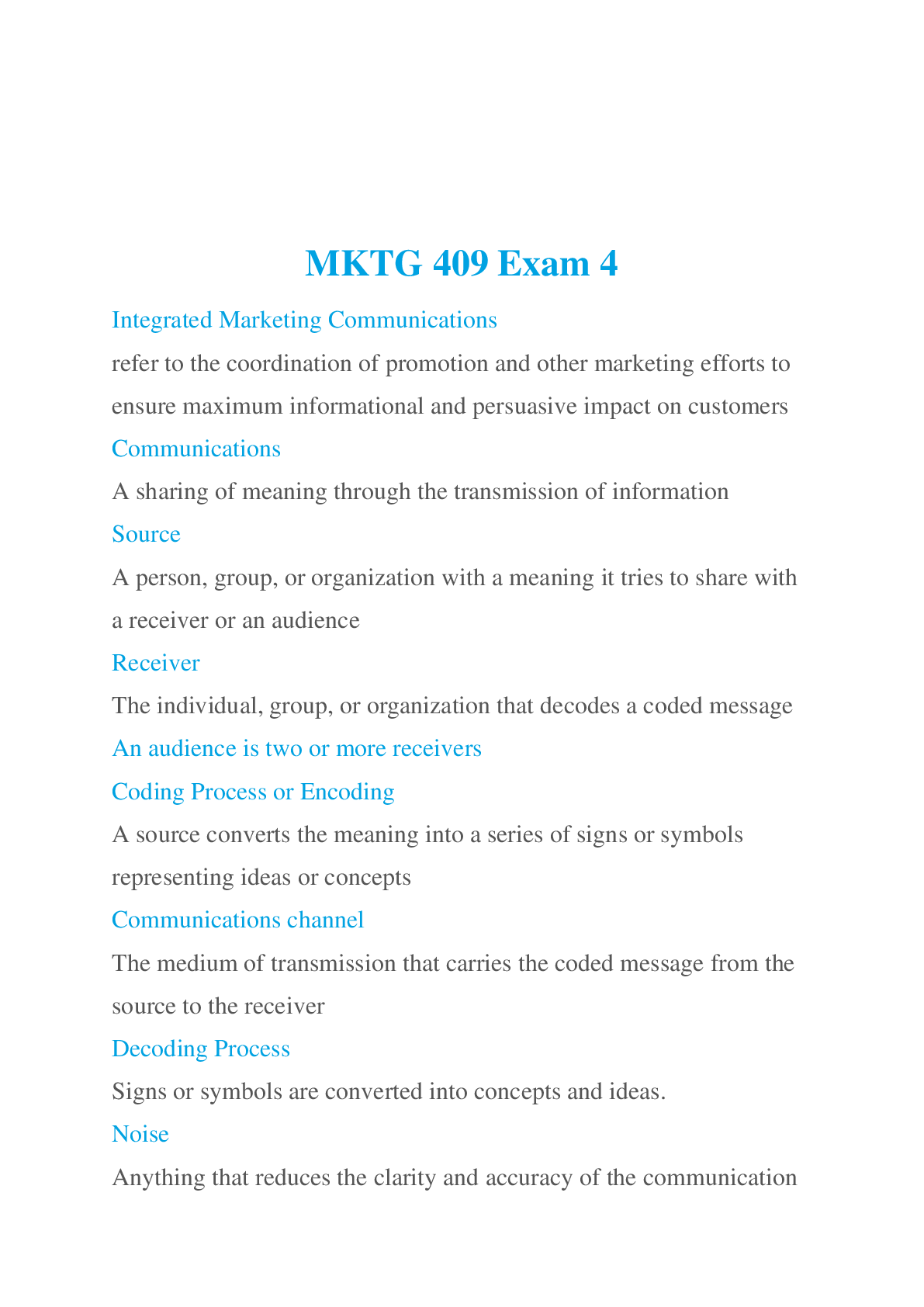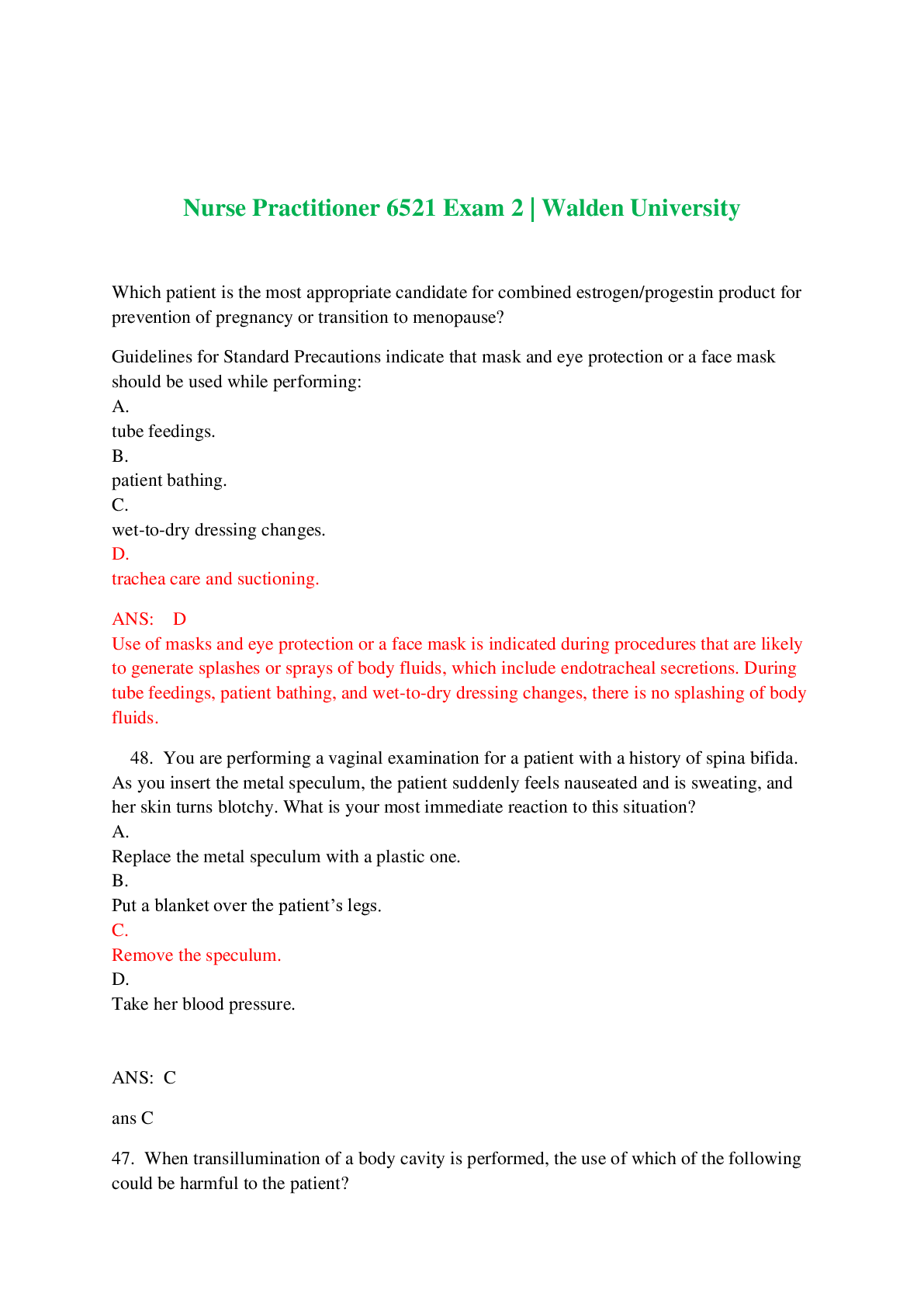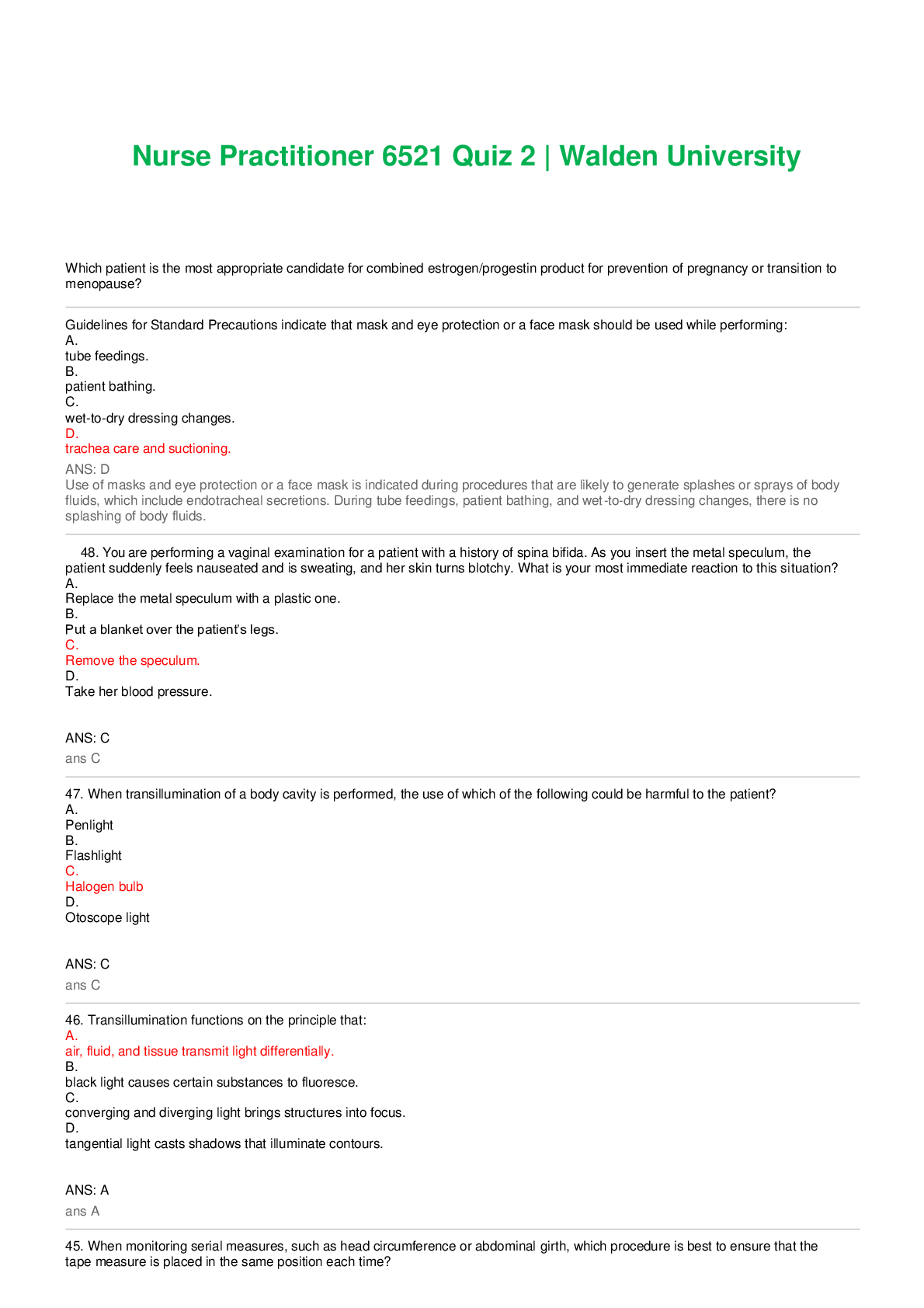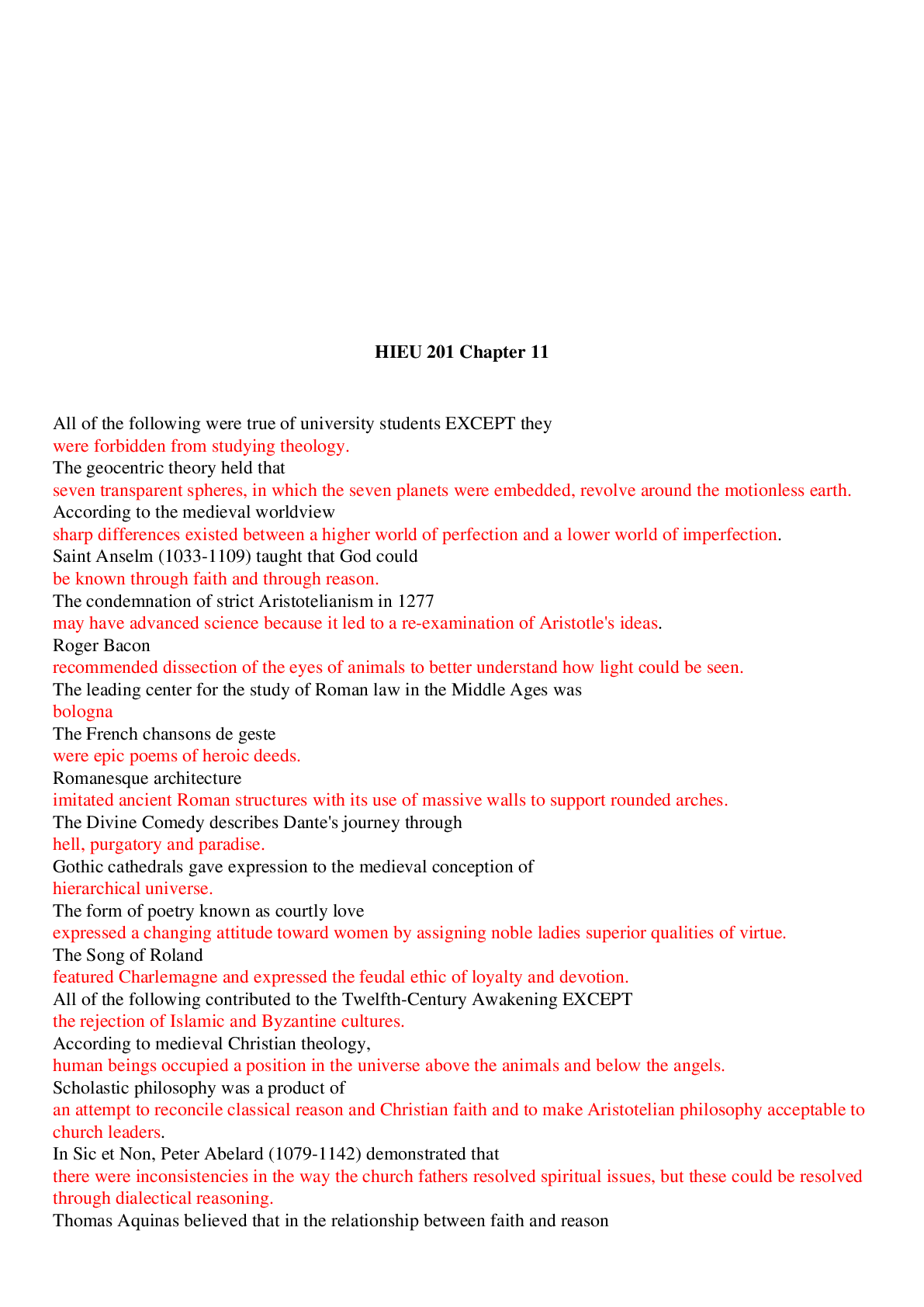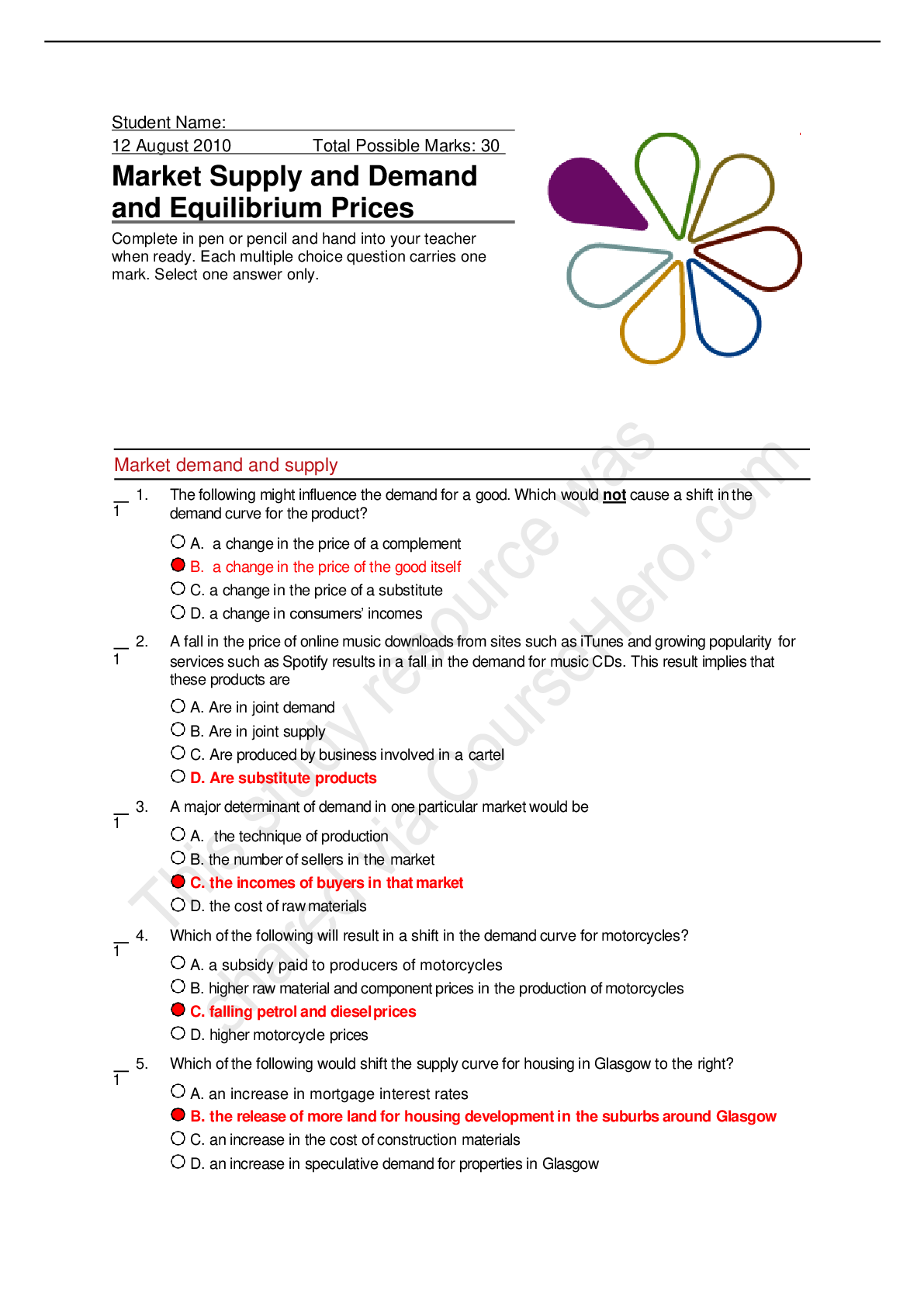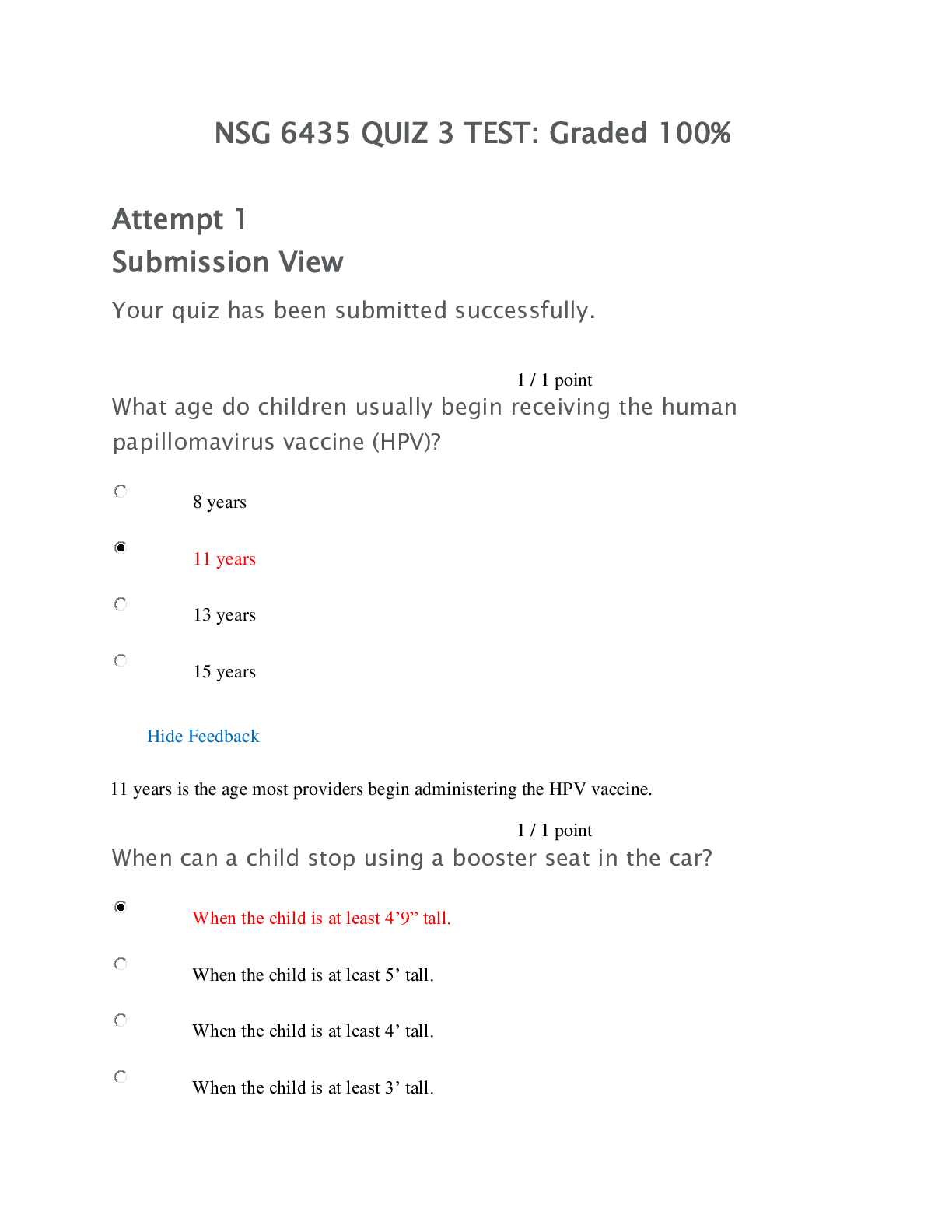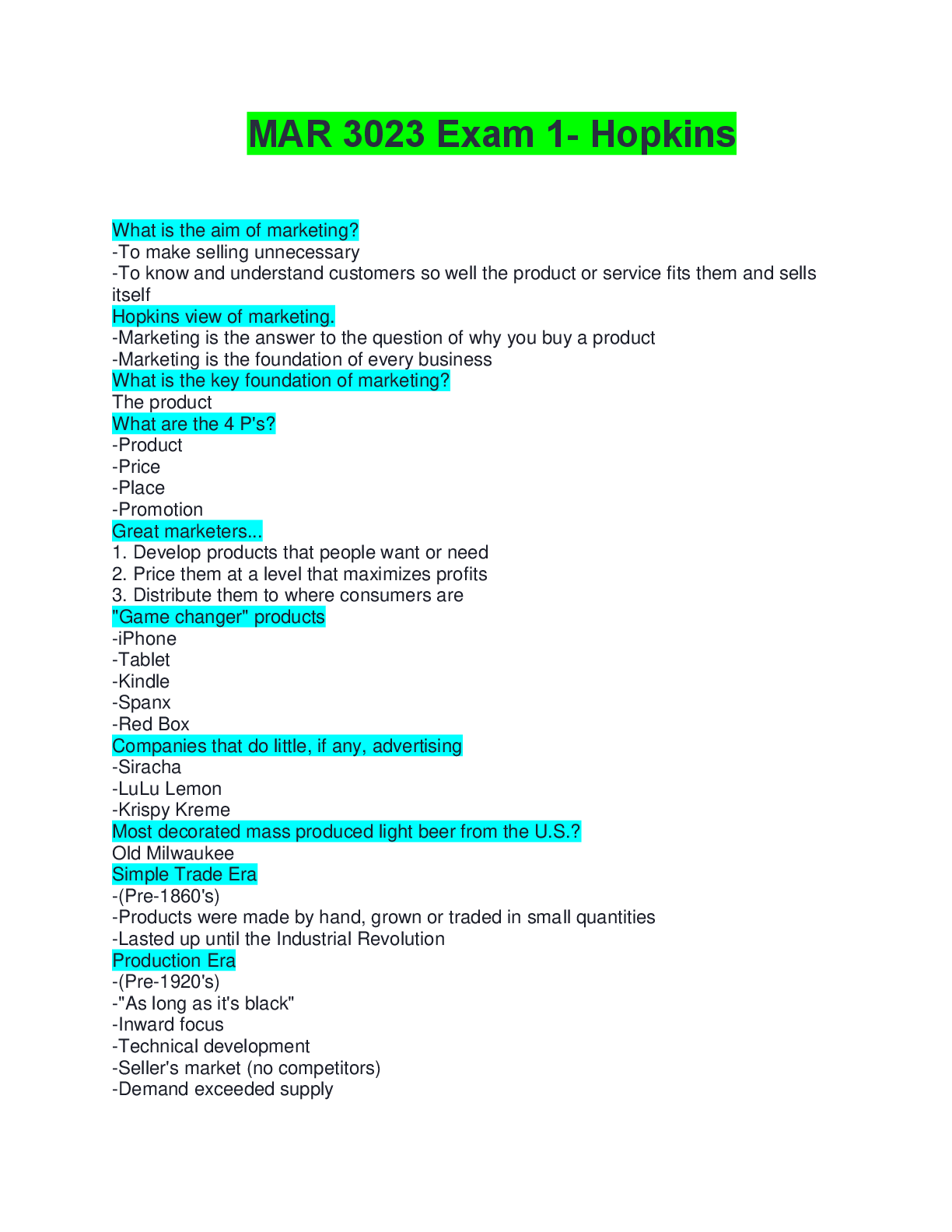Bio 1A03 Mid-Term II_ Study Guide and Practice Questions
Document Content and Description Below
Bio 1A03 Study Guide and Practice Questions Mid-Term - II Compiled and Prepared by The Team of GSGGB at McMaster 1 of 56 Disclaimer This study guide was prepared through the combined effort of ... the team members of Global Society of Genetics and Genome Biology at McMaster. The work presented in this document is NOT affiliated with the Department of Biology. We have tried our best to provide the students of Biology 1A03 with an error - free study guide along with practice questions. However, that being said, if you do come across any errors, please know that the Department of Biology IS NOT responsible for it. Please e-mail us at [email protected] or send us a message on our facebook page to notify us about the errors, or any other comments, questions and concerns that you may regarding this document and topics concerning our club. The team hopes that you prepare well, and wishes you good luck for your midterm! 2 of 56 Table of Contents Topic Page Theme 3 Module 1 4 Theme 3 Module 2 7 Theme 3 Module 3 12 Theme 3 Module 4 17 Theme 4 Module 1 21 Theme 4 Module 2 28 Theme 4 Module 3 34 Theme 4 Module 4 42 Practice Questions 46 Answer Key 56 3 of 56 Theme 3, Module 1 Prokaryotic Growth: ● All prokaryotes require essential nutrients for growth and cell division ● These cells can be grown in labs in media that contain all the requirements ● Prokaryotes need to be able to adapt to different growth environments: were gene regulation becomes important Types of Genes: ● DNA of bacterial nucleoid contains the info required to make a response to a change in environment ● Housekeeping genes: required all the time for normal cell function. ○ Constitutively expressed, always being transcribed and translated ○ Genes that are important for structural proteins of the cell, RNA and DNA polymerases, genes coding for ribosomal proteins ○ Maintain same function in different environments ● Regulated genes: turned off and on when needed ○ Transcribed and translated in response to changing environments ○ Allows for production of important enzymes that bring growth to the cell Enzymes: ● Metabolize nutrients ● Important to regulate the expression of enzymes because cells must be able to metabolize nutrients to gain ATP ● Bacterial cells typically metabolize glucose as an energy source, however, in times where glucose is limited, cells can shift to metabolize alternate energy sources Glucose/Lactose Metabolism: ● Cells metabolize glucose before switching to lactose ● Products of glucose metabolism that activate the switch between glucose and lactose ● This makes sense because if the cell is not currently metabolizing lactose, there would be no point wasting resources on making lactose metabolizing proteins ● When lactose becomes available, the cell will shift resources to make these enzymes ● Glucose is a monosaccharide, lactose is a disaccharide made from glucose and galactose ● B-Galactosidase is the lactose metabolizing enzyme; it breaks down lactose into glucose and galactose, providing the cell once again with glucose ● When only lactose becomes available, B-galactosidase genes are transcribed 4 of 56 Jacob and Monod Experiments: ● Researched how E. coli are able to produce the B-galactosidase needed for lactose metabolism ● Determined that the expression of B-galactosidase is dependent upon the presence of lactose in the environment ● Experiment: Grew E. coli in lactose free medium, added lactose, and then removed it again. Measured amount of B-galactosidase in cells. Found that when lactose was added, the amount of this enzyme would steadily increase. Found also that as soon as lactose was removed, the amount of the enzyme would steadily decrease. ● Won Nobel Prize in 1965 Levels of Regulation: ● Gene expression means that the functional gene product is made, modified and activated; i.e. transcription, translation, and post translational modifications must occur ● 3 levels of control; transcriptional level, translational level, post translational level ● If any of these levels of control are disrupted, the protein will not be produced Transcriptional Regulation: ● Controls the amount of mRNA that is produced in the cell ● Proteins called transcription factors bind to the promoter of the gene and recruit RNA polymerase which allows for transcription to occur ● By controlling the binding of proteins to the promoter, the cell can either activate or inhibit transcription ● Slowest level of regulation ● Protein production requires going through all the steps, therefore it takes a while for the protein to be expressed once the gene has been turned on ● Is often associated with more drastic changes to the environment (ex: lactose becoming the main energy source for E. coli) ● Most efficient level of control ● The cell does not waste any energy or resources making mRNA or polypeptide unless it really needs to ● Allows the cell to effectively control its resources on a per need basis Translational Control: ● Initiation of translation in eukaryotes occurs by the binding of the ribosome to the 5’ cap of the mRNA ● Initiation in prokaryotes occurs by the ribosome binding to the Shine Dalgarno sequence ● The rate at which translation occurs affects the amount of protein produced ● Amount of protein produced also depends on the stability of mRNA 5 of 56 Post-Translational Control: ● Modifications to the primary sequence of a protein help the protein fold into a 3D shape ● Modifications help the protein to become active or inactive by driving the assembly into complexes, binding of substrates, or the unmasking of enzymatic domains ● Fastest level of regulation ● Allows cell to have a stockpile of inactive proteins, once cell receives the signal it can quickly modify the inactive proteins to turn them on ● Allow for quick changes to the cellular environment 6 of 56 Theme 3, Module 2 Prokaryotic Transcriptional Regulation ● E. coli are able to detect the changes in nutrient concentrations that occur in its environment. ● We know this by visualizing the graph; changes in bacterial density are correlated to the change in amount of preferred nutrition. ● In response to the changes in nutrients, it utilizes a highly regulated process to shift its process of metabolism ● The two types of nutrient that were studied for E. coli metabolism: glucose and lactose ● E.coli’s preferred nutrient : glucose (we know this because when it is present in a nutrient medium containing both glucose and lactose, it metabolises glucose first) ● When glucose present → it downregulates lactose metabolizing enzymes ● When lactose present (glucose completely utilized) → it upregulates lactose metabolising enzymes ● The level of regulation of enzymes observed in E. coli : transcriptional ● Now that we are aware of its ability to regulate metabolism to switch between nutrients, we need to understand the mechanism (How?) Mechanism of Gene Regulation ● There are 2 environmental cues facilitating change in metabolic processes in E. coli: 1. Change in glucose levels 2. Change in lactose levels ● It was also observed that there was increase in the levels detectable of enzymes beta-galactosidase and lactose permease as E. coli transitioned from glucose to lactose metabolism. 7 of 56 ● Why are these enzymes required for lactose metabolism: 1. Help transport lactose molecules into the cell 2. effective lactose digestion ● Possible mechanisms that can explain the expression of these enzymes: 1. Glucose may be inhibiting these enzymes 2. Lactose may be inducing the expression of these enzymes ● Function of lactose permease: ○ It is a transport protein embedded in the cell membrane ○ Allows lactose to enter the cells ● Function of beta-galactosidase: ○ It present in cytoplasm and cleaves the lactose (disaccharide) into its monomers glucose and galactose. ● Functional relatedness of the beta- galactosidase and lactose permease genes: ○ These genes are clustered together in the genome (as an operon) because they perform similar functions (polycistronic) ○ This confers an organizational and functional advantage to prokaryotes because of its ability to control the transcription of the operon as a unit ● But what is an operon? Operon ● Operon: it is a model of transcriptional gene regulation in prokaryotes. ● Developed by: Francois Jacob and Jacques Monod ● It states that: 1. In bacteria, groups of functionally related genes are organized into transcriptional units along the bacterial chromosome. 2. Gene clusters are transcriptionally controlled by single 'on-off switch'. 8 of 56 ● Components of lac operon: 1. Promoter 2. Operator (switch) 3. Gene cluster ● Operator (lac O): ○ It is a sequence of nucleotides that that inhibit or facilitate transcription. ○ It is also the binding site for repressor protein (expressed by lac I) ● Promoter: ○ An RNA polymerase binding site to transcribe genes ● Result of transcription of operon: ○ long polycistronic mRNA molecule coding for many proteins ○ Polycistronic mRNA is punctuated with start and stop codons for each protein present ● How does the operon work? Exemplifying the Mechanism of Operons - The Lac Operon ● It is one of the operons present in E. coli ● Function: regulation of expression of beta- galactosidase and lactose permease ● It contains the following genes: ● Lac Y: encodes for lactose permease ● Lac Z: encodes for b-galactosidase ● Lac I: Encodes the repressor protein. ○ Function: the repressor protein binds on the operator, thereby restricting RNA polymerase from binding the promoter region, hence inhibiting transcription of lacY and lacZ genes [Show More]
Last updated: 3 years ago
Preview 1 out of 14 pages
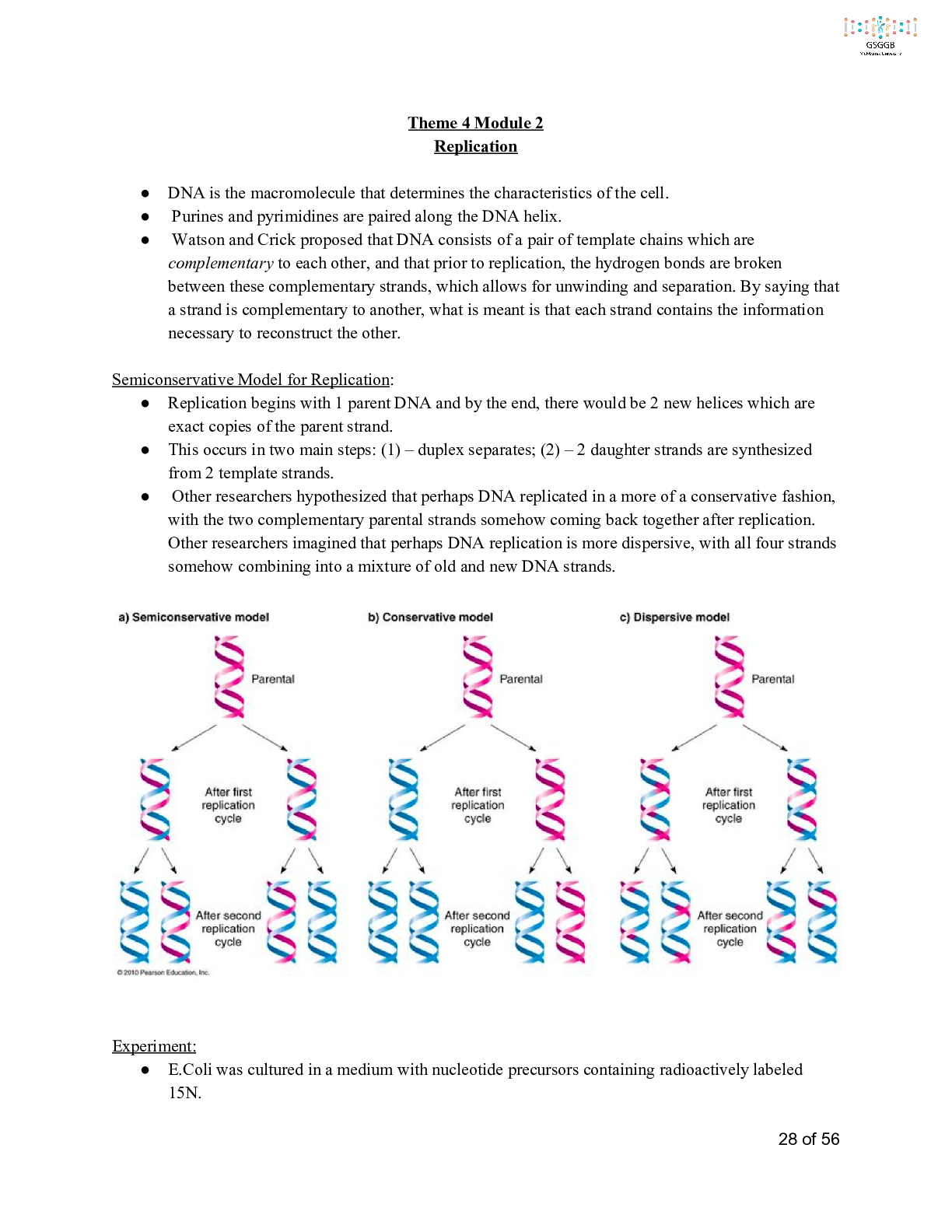
Buy this document to get the full access instantly
Instant Download Access after purchase
Buy NowInstant download
We Accept:

Reviews( 0 )
$10.50
Can't find what you want? Try our AI powered Search
Document information
Connected school, study & course
About the document
Uploaded On
Oct 25, 2021
Number of pages
14
Written in
All
Additional information
This document has been written for:
Uploaded
Oct 25, 2021
Downloads
0
Views
115













